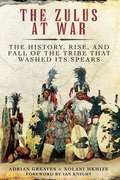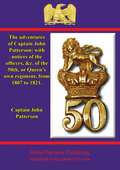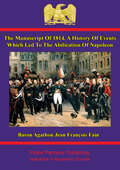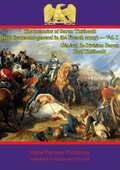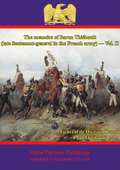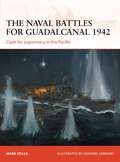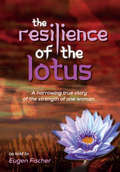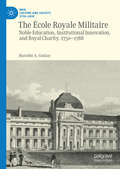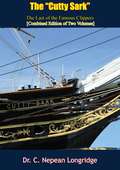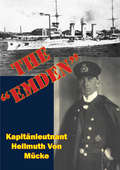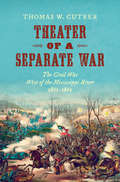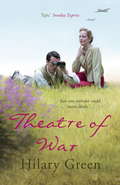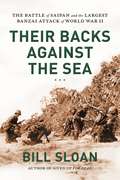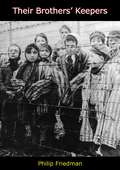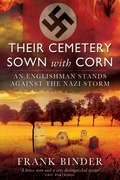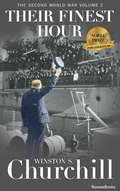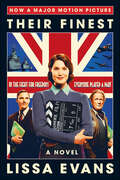- Table View
- List View
The Zulus at War: The History, Rise, and Fall of the Tribe That Washed Its Spears
by Adrian Greaves Xolani MkhizeBy tracing the long and turbulent history of the Zulus from their arrival in South Africa and the establishment of Zululand, The Zulus at War is an important and readable addition to this popular subject area. It describes the violent rise of King Shaka and his colorful successors under whose leadership the warrior nation built a fearsome fighting reputation without equal among the native tribes of South Africa. It also examines the tactics and weapons employed during the numerous intertribal battles over this period. They then became victims of their own success in that their defeat of the Boers in 1877 and 1878 in the Sekunini War prompted the well-documented British intervention. Initially the might of the British empire was humbled as never before by the shock Zulu victory at Isandlwana but the 1879 war ended with the brutal crushing of the Zulu Nation. But, as Adrian Greaves reveals, this was by no means the end of the story. The little known consequences of the division of Zululand, the Boer War, and the 1906 Zulu Rebellion are analyzed in fascinating detail. An added attraction for readers is that this long-awaited history is written not just by a leading authority but, thanks to the coauthor’s contribution, from the Zulu perspective using much completely fresh material.Skyhorse Publishing, as well as our Arcade imprint, are proud to publish a broad range of books for readers interested in history--books about World War II, the Third Reich, Hitler and his henchmen, the JFK assassination, conspiracies, the American Civil War, the American Revolution, gladiators, Vikings, ancient Rome, medieval times, the old West, and much more. While not every title we publish becomes a New York Times bestseller or a national bestseller, we are committed to books on subjects that are sometimes overlooked and to authors whose work might not otherwise find a home.
The adventures of Captain John Patterson: with notices of the officers, &c. of the 50th, or Queen's own regiment, from 1807 to 1821.
by Captain John PattersonCaptain Patterson's adventures are written in a companionable, good natured style which leads the reader through the Peninsular War towards the Pyrenees and Southern France Campaign. This account is filled with much essential information of the campaign and the battlefields, as well as entertaining anecdotes of the author's own experiences and those of his soldiers and comrades. An essential addition to the Napoleonic library of every enthusiast.Author -- Captain John PattersonText taken, whole and complete, from the edition published in London : T. & W. Boone, 1837.Original Page Count - x and 436 pages.
The manuscript of 1814. A history of events which led to the abdication of Napoleon: Written at the command of the emperor, by Baron Fain
by Baron Agathon-Jean-François FainThe 1814 Campaign in France saw Napoleon desperately struggling for survival as the Allies closed in following his defeat at the Battle of the Nations in 1813. Many historians avow that Napoleon's fight to retain his throne and his Empire during the early months of 1814 remain his greatest hour, despite ultimate failure.Along with Napoleon on his lightning campaign were his staff, including Baron Fain, who was Napoleon's secretary. Napoleon would often dictate to his secretaries his musings, correspondence and insights, always at extreme speed and sometimes into the small hours of the night: in short they were privy to his innermost thoughts. After Napoleon's final fall, Fain was given the task of preparing a book to record his experiences and the French point of view of the Campaign. His eyewitness account is an interesting narrative on the battles and military and political events leading to the Emperor's defeat and abdication in 1814.Author -- Baron Fain, Agathon-Jean-François, 1778-1837.Translator -- AnonText taken, whole and complete, from the edition published in London, H. Colburn and co., 1823.Original Page Count - vii, 412 p.Illustrations -- 1 Facsimile.
The memoirs of Baron Thiébault (The memoirs of Baron Thiébault (late lieutenant-general in the French army) #1)
by Arthur John Butler Général de Division Baron Paul-Charles-François-Adrien-Henri Dieudonné ThiébaultGeneral Thiébault was always destined for a career in the military: his father was a professor in the military school in Berlin and a friend of Frederick the Great. Having started as a volunteer in the Revolutionary army, he started to acquire a reputation for his knowledge of military matters and staff work. He was then attached to Army of Italy in 1797, being distinguished for his personal bravery and keen wit, afterward serving under Masséna during the siege of Genoa (1800). His brigade played a pivotal role during the battle of Austerlitz in 1805, bringing significant attention to its commander, as did his work on an instruction book on the function of the army staff. Thiébault felt his service merited high office and was disappointed by the advancement of generals of less talent and his posting to the graveyard of the Peninsular, where he served with as much credit as any commander. His memoirs are invaluable for his critical, often biting assessment of his contemporaries and also for his expert commentary on the military matters.His first volume concentrates on his youthful experiences and his service up to the time of the Army of Italy. Author -- Général de Division Baron Paul-Charles-François-Adrien-Henri Dieudonné Thiébault, 1769-1846Translator -- Arthur John Butler, 1844-1910Text taken, whole and complete, from the edition published in New York, The Macmillan Co., 1896.Original Page Count - x and 491 pages.Illustrations - 1 portrait.
The memoirs of Baron Thiébault (The memoirs of Baron Thiébault (late lieutenant-general in the French army) #2)
by Arthur John Butler Général de Division Baron Paul-Charles-François-Adrien-Henri Dieudonné ThiébaultGeneral Thiébault was always destined for a career in the military: his father was a professor in the military school in Berlin and a friend of Frederick the Great. Having started as a volunteer in the Revolutionary army, he started to acquire a reputation for his knowledge of military matters and staff work. He was then attached to Army of Italy in 1797, being distinguished for his personal bravery and keen wit, afterward serving under Masséna during the siege of Genoa (1800). His brigade played a pivotal role during the battle of Austerlitz in 1805, bringing significant attention to its commander, as did his work on an instruction book on the function of the army staff. Thiébault felt his service merited high office and was disappointed by the advancement of generals of less talent and his posting to the graveyard of the Peninsular, where he served with as much credit as any commander. His memoirs are invaluable for his critical, often biting assessment of his contemporaries and also for his expert commentary on the military matters.His second volume relates his experiences during the Austerlitz campaign, in Spain up to the end of Napoleon's reign.Author -- Général de Division Baron Paul-Charles-François-Adrien-Henri Dieudonné Thiébault, 1769-1846Translator -- Arthur John Butler, 1844-1910Text taken, whole and complete, from the edition published in New York, The Macmillan Co., 1896.Original Page Count - 438 pages.Illustrations - 1 map.
The naval battles for Guadalcanal 1942
by Howard Gerrard Mark StilleThe battle for Guadalcanal that lasted from August 1942 to February 1943 was the first major American counteroffensive against the Japanese in the Pacific, it also marks the high point of Japanese expansion and can justly be claimed as one of the major turning points of the Pacific War. While the troops of the US Marine Corps and later the US Army battled the Japanese occupiers on the densely jungled island of Guadalcanal, the US and Japanese naval forces fought a series of tightly contested battles in the waters nearby. The first of these, the battle of Savo Island on the night of 9 August 1942, saw the Japanese inflict a sever defeat on the Allied force, driving them away from Guadalcanal and leaving the just-landed marines in a perilously exposed position. This was the start of a series of night battles that culminated in the First and Second battles of Guadalcanal, fought on the nights of 13 and 15 November, that were narrowly won by US Naval forces and prevented the Japanese from reinforcing their troops on the island to any great extent, and heralded the turning of the tide in the battle for Guadalcanal. One further major naval action followed, the battle of Tassafaronga on 30 November 1942, when the US Navy once again suffered a severe defeat, but this time it was too late to alter the course of the battle as the Japanese evacuated Guadalcanal in early February 1943.This title will detail the contrasting fortunes experienced by both sides over the intense course of naval battles around the island throughout the second half of 1942 that did so much to turn the tide in the Pacific.
The resilience of the lotus
by Eugen FischerThis story tells the sad truth about a young, displaced woman from Manchuria, her life during the Japanese invasion 1931-1945 and some years thereafter. Told to the author in Singapore in the late seventies, it is a harrowing tale of humanity's cruelty and the horrors of war, but also a testament that life always finds a way to survive. Her strength and courage in the horrendous circumstances of war and occupation are inspirational. Like the lotus flower, the human spirit has the potential to grow in the worst environment, and emerge from the muck to bloom again as a beautiful flower. There are so many victims in a war, and once the war is over, one doesn't know their names nor find their graves. The stench of war wilts all flowers. The stench of peace lets them bloom again.
The springs of Virginia: life, love and death at the waters, 1775-1900
by Perceval ReniersVirginia's health resorts from the Revolution to the 20th century.This book presents the Virginia mineral springs. The chief area straddled the continental divide and lay northeast to southwest, with Warm Springs at the top, Gray Sulphur at the bottom, Rockbridge Alum on the east, and Blue Sulphur on the west. The distance between farthest points, either way, was about seventy-five miles. “Almost everyone went in at the Warm Springs and came out the same way” (p. 26). Invalids followed the tour down the center to the White Sulphur for its purging qualities, on to the Sweet for its rehabilitating “tonic,” then to the Salt for its Glauber salt or its iodine, and finally to the Red Sulphur. They then doubled back through the Salt and the Sweet, ending with bathing at the Hot and the Warm (p. 30). But while they sampled the water they also sampled the company, for these were “the fountains most strongly impregnated with minerals, heat, fashion, and fame.” The author presents gaily the various gentlemen innkeepers and how they succeeded or failed; Southern magnates, particularly the South Carolina Singletons and Petigrus and their kin who occupy a substantial portion of the book; Henry Clay, Van Buren, John Tyler; philanthropists like Peabody and Corcoran; and less notable persons from the South, the North, and abroad. Usually Virginians are conspicuous by their absence, except General Lee, and Virginia belles in the more trivial postwar section based on reporters' letters to newspapers.—Journal of American History
The École Royale Militaire: Noble Education, Institutional Innovation, and Royal Charity, 1750-1788 (War, Culture and Society, 1750 –1850)
by Haroldo A. GuízarThis book explores the Paris Ecole Militaire as an institution, arguing for its importance as a school that presented itself as a model for reform during a key moment in the movement towards military professionalism as well as state-run secular education. The school is distinguished for being an Enlightenment project, one of its founders publishing an article on it in the Encyclopédie in 1755. Its curriculum broke completely with the Latin pedagogy of the dominant Jesuit system, while adapting the legacy of seventeenth-century riding academies. Its status touches on the nature of absolutism, as it was conceived to glorify the Bourbon dynasty in a similar way to the girls’ school at Saint Cyr and the Invalides. It was also a dispensary of royal charity calculated to ally the nobility more closely to royal interests through military service. In the army, its proofs of nobility were the model for the much debated 1781 Ségur decree, often described as a notable cause of the French Revolution.
The “Cutty Sark”: The Last of the Famous Clippers [Combined Edition of Two Volumes]
by Dr C. Nepean LongridgeOriginally published in two volumes in 1933, this amalgamated edition provides an in-depth description of the hull, deck fittings, and rigging of this famous ship, together with a detailed account of the building of a scale model, which was added to the collection at the Science Museum in South Kensington, London, England.The first volume gives an account of the ship itself, with plans and full instructions for building the hull, bulwarks, and deck fittings of a scale model.The second volume describes the masts, spars, and rigging of a scale model, and including the builder’s specification for the construction of the original ship.Fully illustrated throughout.
The “Emden”
by Kapitänleutnant Hellmuth Von MückeThe cruiser SMS Emden was part of the German East Asia Squadron based at the Tsingtao in China during the First World War. Designed to be a commerce raider, attacking Allied merchant shipping rather than fleet battle action, she achieved much more than that under the command of her swashbuckling commander Kapitän zur See Karl Friedrich Max von Müller. From the outbreak of hostilities she began to attack the shipping lanes, vital to the Allies, sinking and capturing over 20 vessels in the first few months. She then surprised and sank a Russian cruiser and a French destroyer in the audacious raid on Penang before heading for the Cocos Islands to wreck British naval assets there. Unfortunately for the Emden and her crew, they were hunted down by the more powerful HMAS Sydney and the raider was forced to run aground. The epic efforts of the Emden and her crew are herein brought to life through the memoirs of her First officer, Kapitänleutnant Hellmuth Von Mücke.Following the end of the Emden the majority of the surviving crew were captured, but Von Mücke led a group all the way back to Germany in the commanded schooner Ayesha - this epic journey is told in a companion book the "Ayesha".
Theater of a Separate War: The Civil War West of the Mississippi River, 1861–1865 (Littlefield History of the Civil War Era)
by Thomas W. CutrerThough its most famous battles were waged in the East at Antietam, Gettysburg, and throughout Virginia, the Civil War was clearly a conflict that raged across a continent. From cotton-rich Texas and the fields of Kansas through Indian Territory and into the high desert of New Mexico, the trans-Mississippi theater was site of major clashes from the war's earliest days through the surrenders of Confederate generals Edmund Kirby Smith and Stand Waite in June 1865. In this comprehensive military history of the war west of the Mississippi River, Thomas W. Cutrer shows that the theater's distance from events in the East does not diminish its importance to the unfolding of the larger struggle.Theater of a Separate War details the battles between North and South in these far-flung regions, assessing the complex political and military strategies on both sides. While providing the definitive history of the rise and fall of the South's armies in the far West, Cutrer shows, even if the region's influence on the Confederacy's cause waned, its role persisted well beyond the fall of Richmond and Lee's surrender to Grant. In this masterful study, Cutrer offers a fresh perspective on an often overlooked aspect of Civil War history.
Theatre Shoes
by Noel StreatfeildWhen their father is captured during the war, three children come to London to live with their grandmother and join their talented theatrical family in a school for stage training.
Theatre in Europe Under German Occupation
by Anselm HeinrichThe Second World War went beyond previous military conflicts. It was not only about specific geographical gains or economic goals, but also about the brutal and lasting reshaping of Europe as a whole. Theatre in Europe Under German Occupation explores the part that theatre played in the Nazi war effort. Using a case-study approach, it illustrates the crucial and heavily subsidised role of theatre as a cultural extension of the military machine, key to Nazi Germany’s total war doctrine. Covering theatres in Oslo, Riga, Lille, Lodz, Krakau, Warsaw, Prague, The Hague and Kiev, Anselm Heinrich looks at the history and context of their operation; the wider political, cultural and propagandistic implications in view of their function in wartime; and their legacies. Theatre in Europe Under German Occupation focuses for the first time on Nazi Germany’s attempts to control and shape the cultural sector in occupied territories, shedding new light on the importance of theatre for the regime’s military and political goals.
Theatre of War
by Hilary GreenIt is 1942. The theatres of war are North Africa and Italy. All eyes follow the front, but behind the scenes a messier war continues, an improvised game of snatched triumphs, terrible mistakes and terrifying uncertainty.Cabaret singer by night, spy by day, Richard risks his life to help British servicemen escape occupied France and get back to England. Rose leads a group of dancers with mixed morals high-kicking to entertain the troops as Hitler's bombers roar in the skies above. Then she is given orders to join the forces in the field, destination unknown.Meanwhile a phantom pianist, who has lost the love of his life, is following Montys soldiers across the African desert, mocking the enemies guns by playing Beethoven between the lines.
Theatre of War
by Hilary GreenIt is 1942. The theatres of war are North Africa and Italy. All eyes follow the front, but behind the scenes a messier war continues, an improvised game of snatched triumphs, terrible mistakes and terrifying uncertainty.Cabaret singer by night, spy by day, Richard risks his life to help British servicemen escape occupied France and get back to England. Rose leads a group of dancers with mixed morals high-kicking to entertain the troops as Hitler's bombers roar in the skies above. Then she is given orders to join the forces in the field, destination unknown.Meanwhile a phantom pianist, who has lost the love of his life, is following Montys soldiers across the African desert, mocking the enemies guns by playing Beethoven between the lines.
Their Amish Reunion (Amish Seasons #1)
by Lenora WorthAn ex-Navy SEAL returns to the Amish life—and the woman—he left behind in this inspirational romance series opener by a New York Times–bestselling author.Widowed single mother Ava Jane Graber can’t believe her eyes. Her first love is back in Lancaster County. Years ago, Jeremiah did the unthinkable: left the Amish—and her—for the Navy SEALs. Now the prodigal hero wants redemption from his community, his family and from the woman he never forgot. For the ex-soldier, becoming Ava’s husband is his ultimate mission.
Their Baby Blessing: A Fresh-Start Family Romance
by Heidi McCahanA military man comes home to be a father to a baby boy and falls for the child's guardian in this small town inspirational romance.The navy prepared him for anything . . . except an instant family.When navy veteran Gage Westbrook promised to look out for his late best friend’s son, he never imagined he’d bond with the baby boy. And he definitely didn’t plan to fall for Connor’s gorgeous temporary guardian, Skye Tomlinson. But weighted by guilt for the accident that took Connor’s dad, can Gage find the courage to forgive himself and embrace the chance at a family?
Their Backs against the Sea: The Battle of Saipan and the Largest Banzai Attack of World War II
by Bill SloanIn the midst of the largest banzai attack of the war, US Army Lt. Col. William O'Brien, grievously wounded and out of ammunition, grabbed a sabre from a fallen Japanese soldier and flailed away at a small army of assailants, screaming to his men, "Don't give them a damn inch!" When his body was recovered the next day, thirty dead enemies were piled around him.The Battle of Saipan lasted twenty-five hellish days in the summer of 1944, and the stakes couldn't have been higher. If Japan lost possession of the island, all hope for victory would be lost. For the Americans, its capture would result in secure air bases for the new B-29s that would put them within striking distance of the Japanese homeland. The outcome of the war in the Pacific lay in the balance.In this gritty, vivid narrative, award-winning author Bill Sloan fuses fresh interviews, oral and unit histories, and unpublished accounts to describe one of the war's bloodiest and most overlooked battles of the Pacific theater. Combining grunt's-view grit with big picture panorama (and one of the ugliest inter-service controversies of the war), Their Backs against the Sea is the definitive dramatic story of this epic battle--and an inspiring chronicle of some of the greatest acts of valor in American military history.
Their Brothers’ Keepers
by Philip FriedmanThis book documents the tales of scores of Christian heroes and heroines from all walks of life, in various European countries, who aided the oppressed escape the Nazi terror.Christians in Czechoslovakia, Yugoslavia, Bulgaria, Greece, France, Italy, Hungary and Eastern Europe defied Gestapo truncheons to be their brothers’ keepers. Fully documented addition to material which has not been treated before in this way.“...One of the most thrilling stories of our generation, excitingly written and well-documented...it serves as an inspiration for all those who have the courage to express their love to their fellowman...”—The Very Rev. JAMES A. PIKE, Dean of the Cathedral of St. John the Divine in New York“...a major document of human solidarity, this story testifies to the survival of the spirit of heroism, as well as of martyrdom, in behalf of humanitarian ideals.”—Professor SALO W. BARON, Columbia University“...I commend this work to all who are interested in seeing how people reached up gentle hands and took Christ’s law of love out of the sky and...put it into practice...I hope it is read by millions.”—Rev. JOHN A. O’BRIEN, University of Notre Dame
Their Cemetery Sown with Corn: An Englishman's Stand Against the Nazi Storm
by Frank BinderJohn Arnold is a young Englishman studying at Bonn University in the early 1930s. Living with a German family in a nearby village his witnesses the pervasive rise of Nazi power in the tight knit community. His position as a guest is complicated by his love of Germany and his burgeoning relationship with both a wealthy and influential Jewess and the maid in the house where he is lodging. Arnold finds it increasingly hard to stand silent witness to the changing political order, which relies on coercion and brutality rather than popular support.This compelling story of love, loyalty and courage in the face of extortion, treachery and murderous cruelty is semi-autobiographical. Having studied in Germany over this period, Binder inevitably draws on his own experiences and observations but invents and develops a rich cast of characters who are forced to come to terms with Hitlers oppression.Anyone who has wondered how a country as cultured and civilized as Germany could have yielded to a barbarous dictatorship must read this book.Frank Binder was a lecturer at Bonn University during the 1930s. He may have been a British spy; certainly, he was well qualified for the task. Eventually he was forced to flee the Nazi regime for refusing to Heil Hitler, leaving behind his priceless collection of books and all his possessions. Paradoxically the British authorities imprisoned him during the Second World War as he declared himself a conscious objector.Sown With Corn was discovered only recently and has been greeted with critical acclaim. Binders reputation would have undoubtedly been further enhanced during his lifetime had this stunning work not have lain undiscovered for some seventy years. Frank Binder died in 1959.
Their Finest Hour (Winston S. Churchill The Second World Wa #2)
by Winston S. ChurchillThe second volume in the WWII history &“written with simplicity, lucidity, and gusto&” by the legendary leader and Nobel Prize winner (The New York Times). In Their Finest Hour, Winston Churchill describes the invasion of France and a growing sense of dismay in Britain. Should Britain meet France&’s desperate pleas for reinforcements or conserve their resources in preparation for the inevitable German assault? In the book&’s second half, entitled simply &“Alone,&” Churchill discusses Great Britain&’s position as the last stronghold against German conquest: the battle for control of the skies over Britain, diplomatic efforts to draw the United States into the war, and the spreading global conflict. Their Finest Hour is part of the epic six-volume account of World War II told from the viewpoint of a man who led in the fight against tyranny, and enriched with extensive primary sources including memos, letters, orders, speeches, and telegrams, day-by-day accounts of reactions as the drama intensifies. Throughout these volumes, we listen as strategies and counterstrategies unfold in response to Hitler&’s conquest of Europe, planned invasion of England, and assault on Russia, in a mesmerizing account of the crucial decisions made as the fate of the world hangs in the balance.
Their Finest Hour: Stories of the Men Who Won the Battle of Britain
by Nick ThomasTheir Finest Hour tells the fascinating stories of six of Churchills Few', each of whom played an important part in the Battle of Britain. Celebrated and much respected on their own squadrons, all have since faded into obscurity. Their achievements, against all odds, and the fortunes of their comrades-in-arms, many of whom died during the Battle, are told here in detail, some for the first time. This has been done in an effort to retrieve these stories from obscurity, bringing them to a wider audience and ensuring they are not forgotten. Featured stories include that of Flying Officer Reginald Peacock DFC, the only Blenheim pilot of the Second World War to become a fighter ace; Squadron Leader Robert Reid, who flew throughout the Battle of Britain, having a hand in the destruction of three Bf 109s, and the damaging of two more; and Pilot Officer Douglas Cyril Winter, who flew Spitfires during the defence of the Dunkirk Beaches, before taking on the Luftwaffe in the skies over Southern England.All these stories offer insights into this dynamic period of aviation history. Recorded here, they serve as poignant reminders of the efforts of the 'Few' and the contributions that they made to the Allied effort during the Second World War.
Their Finest: A Novel
by Lissa EvansFrom the acclaimed author of Crooked Heart comes another “smart, funny, ingenious, revealing tale of London life during the Second World War” (The Independent).It is 1940. France has fallen, and only a narrow strip of sea lies between Great Britain and invasion. Now is the time when everyone must do their part. Young copywriter Catrin Cole is drafted into the Ministry of Information to help “write women” into propaganda films—something that the men aren’t very good at.Her first assignment is a heart-warming—and completely fabricated—tale of bravery and rescue at Dunkirk. With so many called to service, Catrin and her team must make do with the industry’s jaded leftovers: Ambrose Hilliard, third most popular British film-star of 1924; Edith Beadmore, Madame Tussauds wardrobe assistant turned costumier; and Arthur Frith, whose peacetime job as a catering manager has not really prepared him for his unexpected elevation to Special Military Advisor.Now in a serious world, in a nation under siege, they must all swallow their mutual ill-will and unite for the common good, for King and Country, and—in one case—for better or worse. . . . Now a major motion picture starring Gemma Arterton, Sam Claflin, and Bill NighyOriginally published as Their Finest Hour and a Half
Their Rancher Protector (Texas Cowboys & K-9s #2)
by Sasha SummersWill Operation Dog DeliveryBecome Operation Family Found? Skylar Davis is grateful to have the dog her husband nursed back to health on his last deployment. But the struggling widow can barely keep her three daughters fed, much less a hungry canine. Kyle Mitchell&’s soldier&’s instincts won&’t leave them behind—they&’ll all come live at his ranch. Her husband was his best friend, after all. And Skylar? He&’ll give her the love she deserves…if she&’ll forgive him when his secrets are exposed.From Harlequin Special Edition: Believe in love. Overcome obstacles. Find happiness.Texas Cowboys & K-9sBook 1: The Rancher's Forever FamilyBook 2: Their Rancher Protector
